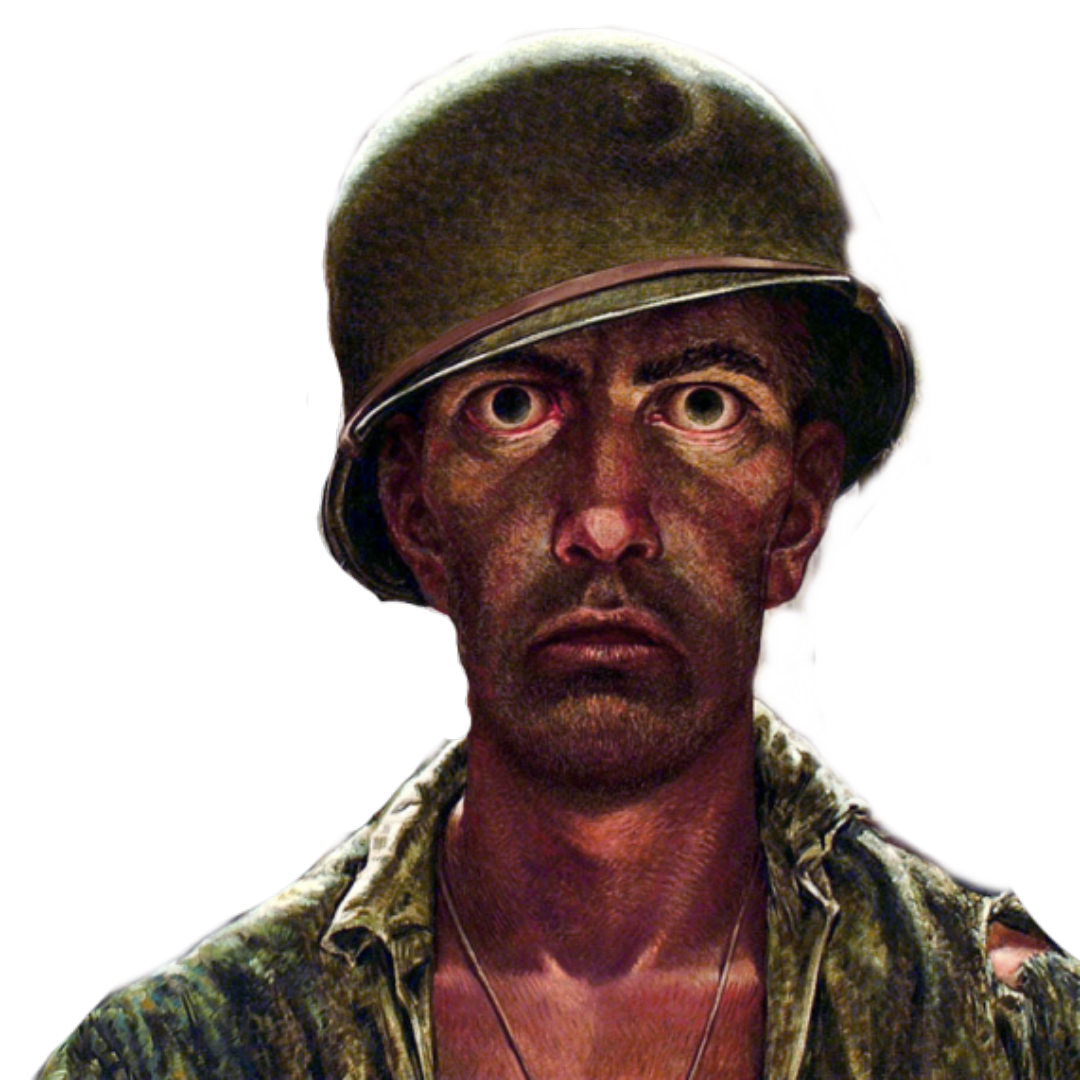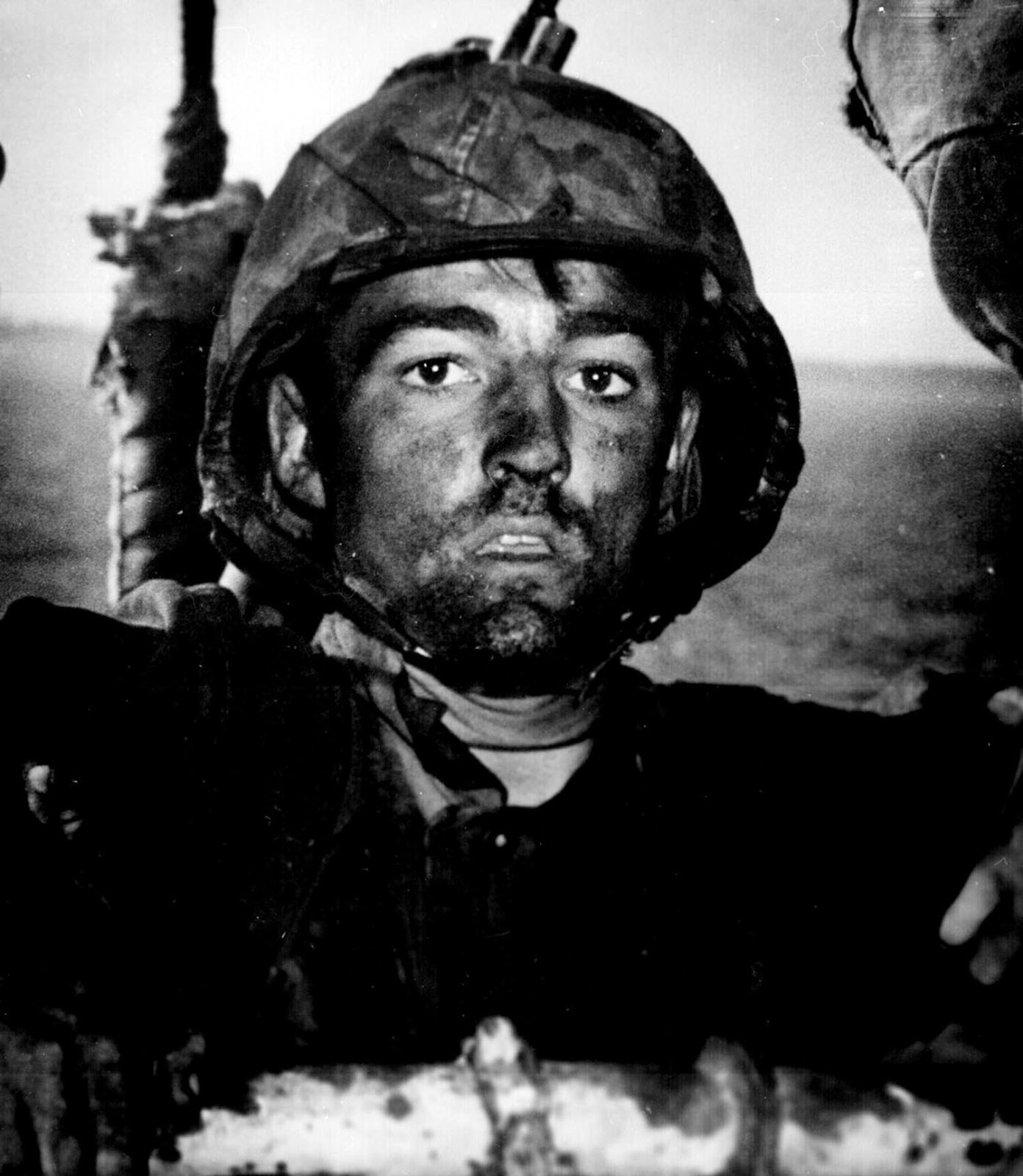Understanding The 1000 Yard Stare: Meaning & Impact
Can a single gaze truly encapsulate the horrors of war, the weight of trauma, and the depths of psychological distress? The "thousand-yard stare" is more than just a look; it's a potent symbol of the invisible wounds carried by those who have witnessed unimaginable suffering.
Born from the battlefields of World War I, the phrase "thousand-yard stare" describes a specific expression: wide, unfocused eyes, often with dilated pupils, fixed on a distant, unseen point. This isn't merely a physical reaction; it's a complex psychological response, a manifestation of the intense stress, shell shock, and trauma experienced in combat. Soldiers, forced to constantly scan the horizon for threats, to witness the brutality of war, and to endure the loss of comrades, often retreated into this vacant stare, a form of emotional detachment as a coping mechanism.
The "thousand-yard stare" became a powerful image, capturing the essence of the psychological impact of war. It represents a state of dissociation, a retreat from the present reality as a means of self-preservation. The individual may appear unresponsive, lost in a world of their own, disconnected from their surroundings. This isn't a sign of weakness; it's a testament to the immense psychological strain endured. The expression reflects the internal battles fought long after the physical fighting has ceased.
- Aishah Sofey Fitness Lifestyle Entrepreneurship Explore Now
- Remote Iot Access Vpc Ssh Raspberry Pi Setup
The image gained further recognition with the painting "Marines Call it That 2,000 Yard Stare" by Tom Lea. This artwork, published by Life magazine, depicts a nameless U.S. Marine during the Battle of Peleliu in 1944. Though the painting wasn't initially titled with the phrase, it became synonymous with the condition. The marine's vacant gaze and gaunt features perfectly convey the psychological toll of combat.
The "thousand-yard stare" isn't exclusive to military personnel. It can manifest in anyone who has endured severe trauma, witnessed horrific events, or experienced acute stress. The expression is a gestural or expressive manifestation of deep psychological trauma or distressing events sustained over time. It represents a breakdown in the ability to process and integrate overwhelming experiences.
The term has evolved beyond its military origins, now referring to various mental health conditions. It serves as a reminder of the profound impact of trauma, highlighting the need for empathy, understanding, and support for those struggling with its effects. The "thousand-yard stare" is a visual cue to the invisible wounds that can linger long after the physical scars have healed.
It's important to distinguish between the "thousand-yard stare" and other expressions of contemplation or daydreaming. While anyone can stare into the distance, the "thousand-yard stare" is linked to a specific psychological state, a result of traumatic experiences. It is not a casual expression; it is a sign of distress.
The "thousand-yard stare" is a symptom, not a diagnosis. It reflects the emotional and psychological consequences of trauma. It can be a sign of Post-Traumatic Stress Disorder (PTSD), a condition that can significantly impact an individual's life. Symptoms may include flashbacks, nightmares, anxiety, and avoidance behaviors, as well as the "thousand-yard stare."
Those who experience the "thousand-yard stare" often struggle with their mental well-being. It's essential to seek professional help if you recognize the symptoms of trauma or PTSD in yourself or someone you know. Therapy, such as cognitive-behavioral therapy (CBT) and eye movement desensitization and reprocessing (EMDR), can be effective in processing traumatic memories and reducing symptoms. Support groups and other resources, such as tapping, can also aid in the healing process.
The term "thousand-yard stare" has also found its way into popular culture, reflecting the widespread recognition of its meaning. It has appeared in movies, books, and video games, often used to portray characters who have experienced trauma. This helps to raise awareness about the challenges faced by individuals struggling with mental health issues.
The phrase "thousand-yard stare" is now commonly associated with combat stress and witnessing severe trauma, or horrific sights. The experience can be jarring, and the individual may react strongly when brought back to the present. The experience can also be linked to dissociation, a mental state of being disconnected from one's body, thoughts, feelings, surroundings, or sense of identity.
Beyond the military context and the trauma associated with warfare, the "thousand-yard stare" has a presence within the gaming community. For instance, within the "Ultrakill" and "Helldivers" communities on platforms like Reddit. These online spaces are dedicated to sharing content and discussing these games. The mention of "1000 yard stare" in these communities is often used metaphorically or to refer to in-game items or conditions, reflecting the game's association with stressful experiences.
Moreover, in "Destiny 2," a popular online multiplayer game, "1000 yard stare" is a sniper rifle in the game, with specific perks and rolls that enhance its performance. Players discuss their preferred "god rolls", maximizing the weapon's effectiveness in player-versus-player (PvP) scenarios. Thus, the term becomes part of the game's lexicon, often linked to features.
Furthermore, the term is mentioned within communities like "Lethal Company," a subreddit. These communities indicate that the term's usage extends beyond the initial context, appearing in discussions about various experiences, in-game elements, or mental states, where it symbolizes intense focus or the effects of stressful events. This wide use of the phrase, reveals its integration within diverse contexts.
The painting, "Marines Call it That 2,000 Yard Stare" by Tom Lea, became a powerful representation of the psychological impact of war and a cultural icon. It captures the essence of the "thousand-yard stare" and its association with the trauma experienced by soldiers. The painting, which depicts an unnamed U.S. Marine in the Battle of Peleliu, portrays the emptiness and fatigue in the soldier's eyes.
This phrase became associated with the psychological aftermath of wartime experiences. It expanded the scope of the term, extending it to various mental health conditions and stressful events beyond the battlefield. The phrase is now used as a symbol of the enduring psychological damage caused by trauma, serving as a reminder of the need for compassion and understanding of mental health challenges.
The phrase also gained popularity, in part, through the publication of "Marines Call it That 2,000 Yard Stare" in Life magazine. The painting, which depicts a marine experiencing this state, captured the public's attention and solidified its association with the psychological impact of war. The painting's impact was substantial.
The "thousand-yard stare" became a symbol of the invisible wounds of war, a visual representation of the psychological toll that combat takes on soldiers. This phrase and its associated imagery, have resonated with audiences and played a role in raising awareness about mental health challenges, emphasizing the need for better support for people affected by trauma.
It's crucial to remember that the "thousand-yard stare" is a symptom, not a diagnosis. It's a sign that someone is struggling with a deep psychological wound. If you recognize this expression in yourself or someone else, seek professional help. There is hope for healing. With therapy, support, and understanding, individuals can begin to process their trauma and find peace.
The "thousand-yard stare" remains a powerful symbol of the human cost of conflict and trauma. It serves as a reminder of the importance of compassion, understanding, and access to mental health care. It's a call to recognize the invisible wounds and to support those who carry them.



Detail Author:
- Name : Willa Schiller I
- Username : joreilly
- Email : toy.lukas@hotmail.com
- Birthdate : 1973-06-28
- Address : 105 Hoeger Cliffs Apt. 498 Darrylfort, NM 32109-0843
- Phone : 1-912-806-3176
- Company : Feeney LLC
- Job : Vocational Education Teacher
- Bio : Quae et et esse labore quis amet. Eos nihil id reprehenderit. Ducimus delectus ut dolor fugiat sint et consequatur. Asperiores ipsam et incidunt aspernatur.
Socials
facebook:
- url : https://facebook.com/brolfson
- username : brolfson
- bio : Consequatur deserunt aut ducimus illo. Autem ex sunt corporis illo aut.
- followers : 1661
- following : 571
tiktok:
- url : https://tiktok.com/@rolfsonb
- username : rolfsonb
- bio : Ea voluptas recusandae cumque velit et.
- followers : 4946
- following : 338
twitter:
- url : https://twitter.com/betty_real
- username : betty_real
- bio : Id corporis necessitatibus porro iure aut quia in. Et eos incidunt non quod quaerat nostrum quis. Qui earum at quia aut. Facere id sint earum voluptas quos et.
- followers : 1635
- following : 2229
linkedin:
- url : https://linkedin.com/in/betty.rolfson
- username : betty.rolfson
- bio : Et amet eum rem sed et corrupti rerum.
- followers : 4365
- following : 202
instagram:
- url : https://instagram.com/betty_rolfson
- username : betty_rolfson
- bio : Tempore maxime excepturi saepe a. Veritatis atque expedita quis ut ipsa qui exercitationem qui.
- followers : 4440
- following : 1807